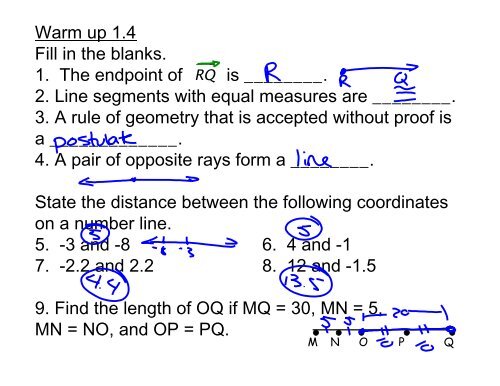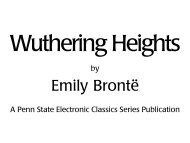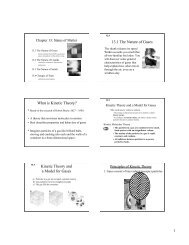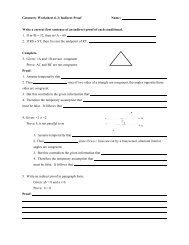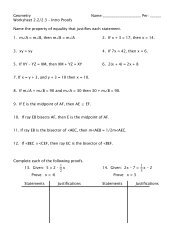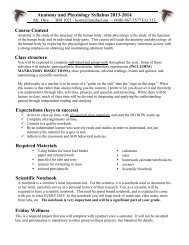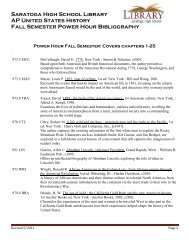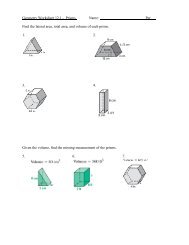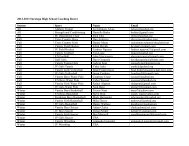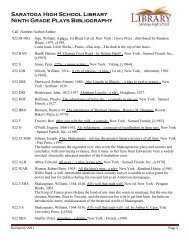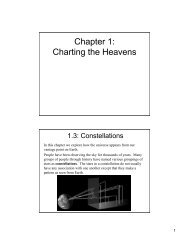2. Line segments with equal measures are ______. - Saratoga High ...
2. Line segments with equal measures are ______. - Saratoga High ...
2. Line segments with equal measures are ______. - Saratoga High ...
You also want an ePaper? Increase the reach of your titles
YUMPU automatically turns print PDFs into web optimized ePapers that Google loves.
Warm up 1.4<br />
Fill in the blanks. <br />
1. The endpoint of RQ is ________.<br />
<strong>2.</strong> <strong>Line</strong> <strong>segments</strong> <strong>with</strong> <strong>equal</strong> <strong>measures</strong> <strong>are</strong> ________.<br />
3. A rule of geometry that is accepted <strong>with</strong>out proof is<br />
a _____________.<br />
4. A pair of opposite rays form a ________.<br />
State the distance between the following coordinates<br />
on a number line.<br />
5. -3 and -8 6. 4 and -1<br />
7. -<strong>2.</strong>2 and <strong>2.</strong>2 8. 12 and -1.5<br />
9. Find the length of OQ if MQ = 30, MN = 5,<br />
MN = NO, and OP = PQ.<br />
M N O P Q
Thursday Sept 17 th<br />
Warm-up<br />
HW Questions<br />
Notes: 1.4 Angles<br />
Measuring Activity<br />
Notes: 1.5 Postulates & Theorems
Pg. 15 #5-18, 27-40<br />
6. False 8. True 10. True 1<strong>2.</strong> True<br />
14. False 16. False 18. True<br />
28. 30.<br />
3<strong>2.</strong> -7, 5, 8 34. X = 11<br />
36. X = 7 38. Y = 7<br />
40. Z = 5, GE = 5, EH = 6; no
1.4 Angles<br />
angle - consists of two different rays that have the same<br />
initial point.<br />
vertex - the initial point of each ray that forms an angle.<br />
EX<br />
Name the angles in the figure.
_____________ angles have <strong>equal</strong> <strong>measures</strong>.<br />
Two angles in a plane that have a common vertex and a<br />
common side but no common interior points <strong>are</strong> called<br />
__________ angles.<br />
An angle ___________ is the ray that divides the angle into<br />
two congruent adjacent angles.<br />
P<br />
Q<br />
S<br />
R
Measuring Angles
Classifying Angles:<br />
Measure and Example<br />
ACUTE<br />
RIGHT<br />
OBTUSE<br />
STRAIGHT<br />
Measuring Activity!.... worksheet
Ray PT is the angle bisector of
Ray BT bisects
There <strong>are</strong> things that you can assume in Geometry, and there <strong>are</strong> things<br />
you can’t. Let figure them out.<br />
List all the conclusion from the diagram on the<br />
right.<br />
A<br />
D<br />
All points shown <strong>are</strong> coplanar.<br />
line AB, ray BD, and ray BE intersect at B.<br />
A, B, and C <strong>are</strong> collinear<br />
∠ABC is a straight angle.<br />
D is in the interior of ∠ABE.<br />
∠ABD and ∠DBE <strong>are</strong> adjacent angles.<br />
B<br />
C<br />
E<br />
(1) You can’t assume size or measurement. This means that you can’t<br />
assume congruence and right angle.<br />
(2) You can assume relative positions and collinearity.
1.5 Postulates & Theorems<br />
Postulate 5<br />
A line contains at least ____ points; a plane consists at least _____ points not all<br />
in one line; space contains at least ______ points not all in one plane.<br />
Postulate 6<br />
Through any two points there is exactly _____ line.<br />
Postulate 7<br />
Through any three points there is ______ one plane, and through any three<br />
noncollinear points there is __________ one plane.<br />
Postulate 8<br />
If two ______ <strong>are</strong> in a plane, then the line that contains the _____ is in that<br />
plane.<br />
Postulate 9<br />
If two planes intersect, then their intersection is a _______.
Theorem 1-1<br />
If two ______ intersect, then they intersect in exactly one _______.<br />
Theorem 1-2<br />
Through a line and a point not in the line there is exactly one _______.<br />
Theorem 1-3<br />
If two ______ intersect, then exactly one plane contains the _______.<br />
Example<br />
Classify each statement as true or false. Give the definition, postulate or<br />
theorem that supports your conclusion.<br />
1. A given triangle can lie in more than one plane.<br />
False. Through a line and a point not in the line there is exactly 1 plane.<br />
<strong>2.</strong> Any two points <strong>are</strong> collinear.<br />
True. Through any 2 pts there is exactly 1 line.<br />
3. Two planes can intersect in only one point.<br />
False. If 2 planes intersect (int.), then their int. is a line.<br />
4. Two lines can intersect in two points.<br />
False. If 2 lines int., then they int. in exactly 1 pt.
Extra<br />
Quick Quiz<br />
Complete <strong>with</strong> always, sometimes, or never.<br />
always<br />
1. Two points _____________ line in exactly one line.<br />
sometimes<br />
<strong>2.</strong> Three points _____________ lie in exactly one line.<br />
sometimes<br />
3. Three points _____________ lie in exactly one plane.<br />
never<br />
4. Three collinear points _____________ lie in exactly one plane.<br />
sometimes<br />
5. Two planes _____________ intersect.<br />
never<br />
6. Two intersecting lines _____________ in exactly one point.<br />
always<br />
7. Two intersecting lines _____________ intersect in exactly one point.<br />
sometimes<br />
8. Two line _____________ intersect in exactly one point.<br />
always<br />
9. Two intersecting lines _____________ lie in exactly one plane.<br />
10. A line and a point not on that line _____________ never lie in more than one plane.<br />
11. A line _____________ never contains exactly one point.<br />
1<strong>2.</strong> When A and B <strong>are</strong> in a plane, line AB _____________<br />
always<br />
in that plane.
Monday<br />
Homework<br />
Tuesday/<br />
Wednesday<br />
Thursday/<br />
Friday<br />
9/14<br />
Pg. 7 #1-10, 21 - 33<br />
Written exercises<br />
NOT Class Exs<br />
9/15-16<br />
Pg. 15 #5-18all,<br />
27-40all<br />
9/17-18<br />
Pg. 21#1-22all,<br />
#29-34all &<br />
Pg. 25 #5-19 all


